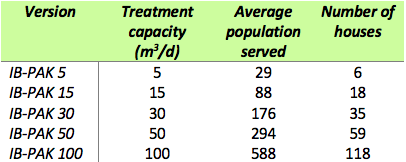Small and medium scale systems
Microplant for house room
The microplant has a prefabricated package-type arrangement and it is designed to treat small wastewater flows. Can be used at homes, offices, buildings, toll highways, etc.
The plant consists of an anaerobic filter and a sequence of submerged aerated filters that together accomplish the removal of organic matter and nitrogen from water. This combination of systems allows treating domestic wastewater with variations in flow, concentration and types of contaminants, aspects that make a difficulty treatment through conventional biological processes.
The unique necessary equipment with moving parts is a silent 60 kW compressor that provides the required oxygen to degrade organic matter, nitrify and execute internal recirculation of water.
In this way, the treated water has a quality that can be reused for irrigation of green areas, floor washing, ornamental fountains, car wash, etc.
Package Plant for domestic water with a capacity of up to 100 m3/d (IBPak®).
The package plants are designed to treat small and medium flows. They have the same processes required in conventional treatments (Pre-treatment, biological process, disinfection and filtration) with the advantage of a compact, modular and prefabricated design, which allows an easy installation.
They are adaptable to user requirements, have reliable and robust mechanical equipment that require minimum maintenance and sludge disposal; also, smells or noise are not generated. Besides, they can be installed in houses and housing developments, sports clubs ang gyms, small businesses and stores, medium industry, as well as medium-capacity hospitals and hotels
The treated water complies with the norm NOM-003-SEMARNAT-1997, so it can be used for irrigations of green areas, unloading in toilets, washing of cars and streets, ornamental fountains, fire protection systems and soil infiltration.

Wetlands.
A wetland consists of a low-rise tank that is packed with gravel and rock, in which plants are sowed. The wastewater flows in a sub-surface way.
The pollutans are removed by the joint action of several physicochemical, biological and microbiological processes used in conventional wastewater treatment plants (sedimentation, filtration, ion exchange, chemical oxidation and reduction, conversion and biological degradation, etc.) or by the plant kingdom organisms that specifically perform the removal (photosynthesis, photo-oxidation, incorporation of matter and nutrients, etc.).
The root bed systems are environmentally friendly, they do not present fly problems or bad odors, the construction is simple, and the operation does not require mechanical or electrical equipment, they have a large buffer capacity that supports a wide range of operating conditions and wastewater composition, operating and maintenance costs are almost zero and, additionally, the effluent quality can comply with NOM-003-SEMARNAT-1997.